All 11 entries tagged Token
No other Warwick Blogs use the tag Token on entries | View entries tagged Token at Technorati | There are no images tagged Token on this blog
August 17, 2017
Gaius Mitreius, Magister Iuventutis, and the Materiality of Roman Tokens
Amongst the ancient tokens kept in the coin cabinet of the Ashmolean Museum in Oxford is this piece struck from brass (orichalchum). One one side is a male bust (perhaps of Mitreius or more generally a representation of "youth") surrounded by the legend C. MITREIVS L. F. MAG. IVVENT - Gaius Mitreius, son of Lucius, master of the youth (the iuventutes was a youth organisation). On the other side is a two-story building with columns that looks very much like a basilica. On the building is inscribed L. SEXTILI∙ S.P. = Lucius Sextilius, at his own expense.
 |
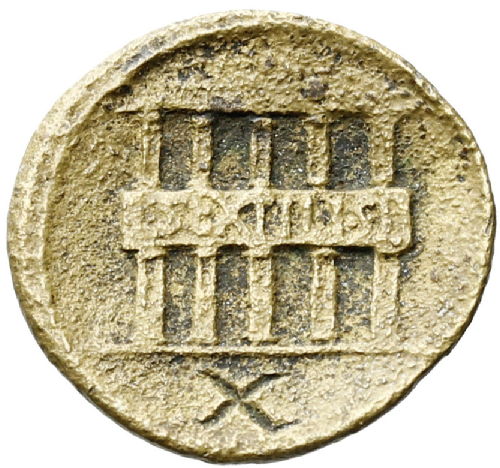 |
Token from the Ashmolean Museum (Oxford). (20mm, 3.58g, die axis 6).
In his analysis of Roman tokens Rostovtzeff discusses this type (p. 60), noting that the example in Paris has a countermark underneath the bust. This piece has the number X (10) etched into the exergue on the reverse, but other specimens carry the numbers VIIII and IIII. The structure on the reverse also varies on different examples (as is typical of numismatic representations of buildings) - other representations show a more circular structure that has been identified as an amphitheatre. The representation of the same or similar scenes with differing numbers is reminiscent of the famous spintriae, bronze tokens that carry sex scenes on one side and differing numbers on the other. The fact that the numbers appear to be incised into the token after it was struck is also similar to a practice known in late antiquity, where contorniates (late antique tokens whose purpose remains debated) where inscribed with Christian symbols, palm branches or other designs after striking. One example of this practice is shown below on a piece from the British Museum: a palm branch has been etched into a contorniate that shows Homer on one side and Bacchus on the other.
 |
We don't know anything further about the Lucius Sextilius named on the token, nor about Mitreius beyond the fact that he held an office connected with the iuventutes, the youth organisations that existed in the western part of the Roman Empire (also known as collegia iuvenes). But we do possess inscriptional evidence for the Mitreius name at Rome and in Gubbio (CIL VI, 28976 and 38641, CIL XI, 5861, AE 1988, 347). A Mitreius token like that shown above was reportedly found on the island of Capri, although this specimen is now lost (Federico and Miranda 1998, 363).
This was not the only token struck by Mitreius in connection with his position as magister iuventutis. He also struck a type with the same obverse (a male bust and his name) with a facing lion's head within a wreath on the reverse. Other bronze types carried the same obverse with a number within a wreath on the reverse (IIII, XI and XII are known - Cohen VIII 12-15, and Triton IV, 449, the specimen pictured below) - this again is very similar to the design of spintriae. Another specimen, now in a private collection, carries Mitreius' name and a tripod on one side and two clasped hands with a poppy seed on the other - this token also appears to be countermarked in the image.
Mitreius was not the only official connected to Roman youth organisations to strike tokens; several types exist in lead that refer to youth groups or to festivals connected to these same groups. One example is shown below: on one side is a youthful male portrait with the legend PPETRI SABI (Publius Petronius Sabinus) and on the other side is the legend MAG VIIII IVV (Magister Iuvenum VIIII - Master of the Youth, Nine) (TURS 834).
 |
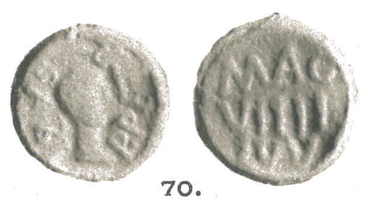 |
| Mitreius bronze token. | Sabinus lead token. |
That officials associated with youth organisations struck tokens in orichalcum, bronze and lead suggests that different materials might be used for tokens that were ultimately used in the same context. In this sense we should study all Roman tokens together as one class of material, rather than, as has previously been the case, separating the bronze from the lead, or the "spintriae" from other types. Clay tokens are also known from Rome, and may also ultimately provide further illumination on what, and in what contexts, these objects were used for. But these types are further evidence that some tokens were used within Roman colleges or other organisations, and may ultimately have been connected to feasts, games, celebrations or festivals.
This blog was written by Clare Rowan as part of the Token Communities Project. Thanks are due to Denise Wilding for undertaking the photography and recording of this and other tokens from the Ashmolean collection.
Bibliography:
Federico, E. and E. Miranda, eds. (1998). Capri Antica. Dalla preistoria alla fine dell'età romana. Capri, Edizioni La Conchiglia.
TURS - Rostowzew, M. (1903). Tesserarum urbis romae et suburbi. St. Petersburg.
Rostowzew, M. (1905). Römische Bleitesserae. Ein Beitrag zur Sozial- und Wirtschaftsgeschichte der römischen Kaiserzeit. Leipzig, Dieterich'sche Verlagsbuchhandlung.
June 16, 2017
Token Characteristics: Some Preliminary Thoughts
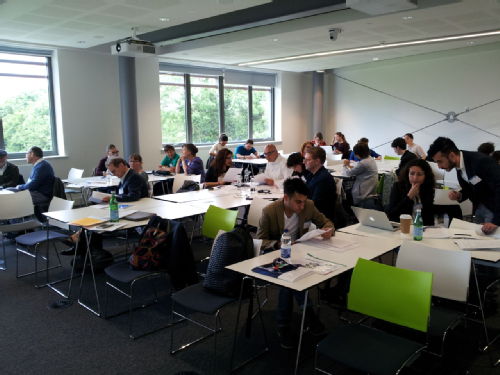 |
|
| Talking Tokens: The Warwick Conference |
Earlier this month, the Token Communities project played host to scholars from around the world for the conference Tokens: Culture, Connections, Communities. As tokens from all periods and places werex presented, I was struck by the way that these objects acted in similar ways across time and space. English defines the word "token" as something representative of something else, "something that serves to indicate a fact, event, object, feeling, etc" (OED). Below are some preliminary thoughts about what might be characteristic of tokens, what they do in human society, and how they interact with hierarchy, human relationships, and human cognition. It is clear that tokens have played a multitude of roles across time, from the prehistoric to the modern day, but here are some characteristics of these objects that emerged from the papers presented at the conference. (And thank you to all who attended!)
Memory Devices
The earliest tokens were used in accounting, to represent, count and redistirbute goods. In this sense they acted as external memory devices to remember our relationships, transactions and obligations with others. But the memory aspect of tokens also manifests itself in other ways. Tokens might also act as souvenirs or mementoes or particular life events, relationships, festivals or other occasions. For example, pilgrim tokens like this pictured here from the shrine of St. Symeon, acted as objects that mementoes that could provoke or embody memories of a pilgrimage to a particular holy site, as Vicky Foskolou's work has shown. Similarly, love or convict tokens acted as an object that embodied the memory of a particular person or relationship. The relative frequency with which tokens from the ancient Mediterranean are found pierced suggests that these objects too may have functioned (in a secondary context) as a memento of a paricular event or person.
 |
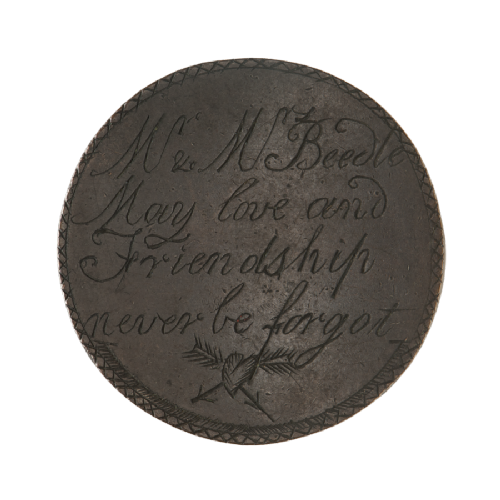 |
| Pilgrim Token from the Shrine of St. Symeon, The Walters Art Museum, Museum purchase with funds provided by the S. & A.P. Fund, 1946 |
Convict love Token. Produced using content from the National Museum of Australia’s Convict love tokens interactive. |
Hierarchy
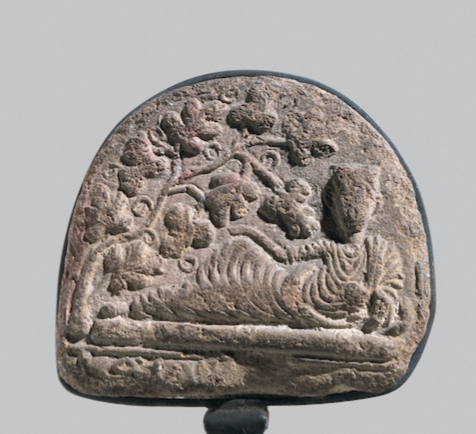 |
| Palmyrene Tessera from the Met. |
By controlling access to particular events, societies or distributions, tokens contribute to the creation and maintenance of particular social hierarchies. The mere existence of tokens suggests a group of those "who have" tokens (and what they represent/provide) and those who "have not". The best known tokens from antiquity are the "banqueting tesserae" of Palmyra in Syria, objects that served as entrance tickets to particular religious banquets in the city. The distirbution of these objects to particular groups in the city would have reinforced particular communities and groups by excluding others, and likely meant that particular cultic spaces within the city became "members only" at particular moments in time. Similarly the use of jetons in early modern France created a dialogue of "inclusion" and "seclusion" that served to reinforce social norms and the hierarchy that existed within the monarchy, as Sabrina Valin has explored.
Money
The relationship between "tokens" and "money" is complex, but there is clearly a relationship at work between the two. Some tokens, whether in antiquity or in the more modern age, acted as a form of money, whether this be small change issued by merchants, or the "company coinage" of groups in the Roman Republic. But in other cases tokens represent money or an amount of money (like the Roman token giving the names of Olympianus and Eucarapus and the sum of 1000 sestertii), mediating transactions in lieu of official money, or in a way that played with official currency. Tokens might act in ways similar to money by ensuring the distribution of goods and efficient account keeping without ever taking on the role of 'money' itself. In many ways tokens are "like money, but different", and perhaps this was intentionally the case in antiquity to ensure a clear delineation between "official money" and other objects that acted in monetary ways. One wonders whether tokens connected to festivals (like those connected to the festival of Isis in Rome) may have acted in this way - 'money but not quite money' used for particular cultic events.
Singularity
One key way in which many tokens appear to have differed from money is that many of them appear to represent a single item (e.g. grain, wine) or are intended for a single use (and thanks to Bill Maurer for this observation!) This "single use" aspect applies to tokens from the prehistoric period (which were thrown away after use) as well as the "tokenisation" used in modern day societies (in credit card transactions for example, where each number released as a token is sequential and individual). By contrast, money circulates and is used again and again, to be exchanged for any number of goods and services.
There is a lot more digesting to do from the conference, and a lot more thinking to be done about what tokens are and what they do in society. Stay tuned! ;-)
This post was written by Clare Rowan as part of the Token Communities in the Ancient Mediterranean project.
June 01, 2017
Let's play with the portrait of Augustus! "Tesserae" and Roman Games
 |
|
Bone gaming piece showing and naming Augustus.
(From Rostovtzeff's 1904 publication of the find).
|
A variety of objects are given the Latin label “tesserae” by modern scholars: mosaic pieces, lead monetiform objects, spintriae, and small circular objects made out of bone or ivory, like the piece pictured above. On one side is a carved portrait of Augustus, while the other side gives his name in Greek (Σεβαστός) and the number one in both Latin and Greek numerals (I in Latin, A in Greek; the Greeks represented numerals through letters). Scholars originally thought that these bone objects, found all over the Roman world, served as tickets to the theatre, amphitheater or circus. But then this “tessera” and fourteen others were found in a child’s tomb in Kerch (Russia) in 1903, and our understanding of these objects changed completely.
Fifteen bone “tesserae” were found in the tomb placed in a wooden and bronze box, neatly stacked in twos. Each piece had an image engraved on one side and on the other a word accompanied by a number in both Latin and Greek. The numbers range from 1 to 15. The designs of the pieces are as follows, according to the publication of Rostovtzeff 1905 (the counters are now in the Hermitage):
- Head of Augustus / CΕΒΑCΤΟC (Augustus), I and A.
- Head of Zeus / ΖΕΥC (Zeus), II and B.
- An "athletic head" (probably Hermes) / [ΕΡΜ]ΗC (Hermes? The legend is partly obliterated), III and Γ.
- Entrance to an Egyptian building / ΕΛΕΥΣΕΙΝ(ΙΟΝ) (Eleuseinion), IIII and Δ
- Head of Herakles / ΗΡΑΚΛΗΣ (Herakles), V and E
- The word ΗΡΑΙ(Α) (Heraia) in a wreath / YII and the letter vau
- Bust of a praetextatus (a young man wearing a toga) / ΛΟΥΚΙΟΥ (a referenece to a Lucius), VII and Z.
- Head of Kronos / ΧΡΟΝΟC (Kronos), VIII and H.
- The Greek letter Θ / ΠΑΦΟΥ in a wreath (shown below).
- Young female head with a hairstyle of the Augustan age / ΑΦΡΟΔΙΤ(Η) (Aphrodite), Χ and I
- Head of Pollux wearing an athletic headband / ΔΙΟCΚΟΡΟC (Dioscurus), XI and IA.
- Head of Castor wearing an athletic band / ΚΑCΤΩΡ (Castor), XII and IB.
- Head of Aphrodite / ΑΦΡΟΔΙΤ(Η) (Aphrodite), XIII and ΙΓ.
- Bust of Isis / ΙCIC (Isis). The inscription is damaged, but III and ΙΔ are visible.
- Head of Hera / [ΗΡ]Α (Hera, although the inscription is damaged), [X]V and IE.
 |
|
Gaming piece no. 9, reproduced from
Rostovtzeff 1905.
|
Numerous other pieces similar to this have been found throughout the Roman world (e.g. Pompeii, Asia Minor, Athens, Syria, Crete, Vindonissa north of the Alps), but a complete set like this is rare, if not unique. Comparison with other pieces reveal that the numbers do not correlate with any particular image; so while Zeus is paired with number two here, on another set he may be number ten or fifteen, for example. Other pieces have the portraits and names of other emperors and empresses, though none later than Nero; some specimens represent Julius Caesar and one piece carries a portrait of a Ptolemy. This, in addition to the find spots (particularly in Pompeii, and in the abovementioned tomb) suggests a production date ranging from the second half of the first century BC to first century AD, although they may, of course, have been used later than this.
 |
|
"Token", Early 1st century, Ivory. 2.9 cm
(1 1/8 in.) Gift of Marshall and Ruth
Goldberg. J. Paul Getty Museum, CC-BY.
|
This complete set has led scholars to conclude that these are gaming pieces. Many of the surviving specimens carry Egyptian, or more specifically, Alexandrian designs. Our number four, for example, likely represents a sanctuary in Eleusis, which was a suburb in Alexandria. Other suburbs in the city, for example Nikopolis, are also shown and named. On the right is an image of one of these pieces: an obelisk stands next to an Egyptian-style building; the other side names Nikopolis and provides the Latin and Greek number four: IIII and Δ. Egyptian deities feature alongside the busts of gods, rulers and other well-known personalities (e.g. athletes, poets, philosophers, characters from comedies). The current theory, then, is that this was an Alexandrian game that then became popular across the Empire in the first century AD. We have no idea how the game was actually played, although it might have been a mixture of a local Egyptian game and the Greek game of petteia (πεττεία).
We might pause to think what it meant that one could play a game in Pompeii, for example, or in modern day Russia, that represented and played with the Alexandrian landscape, its suburbs, buildings and gods. Could the experience be similar to a modern monopoly board, where British streets and locations are experienced and named by people all over the world? I think we should also consider that people thus might also ‘play’ with the emperor’s portrait; how then did this affect people’s experience of the emperor and his family? But finally, since these bone and ivory objects are gaming counters, we should probably stop calling them “tesserae”!
This Coin of the Month entry was written by Clare Rowan as part of the Token Communities in the Ancient Mediterranean Project.
Bibliography:
Alföldi-Rosenbaum, E. (1976). Alexandriaca. Studies on Roman Game Counters III. Chiron 6: 205-239.
Alföldi-Rosenbaum, E. (1980). Ruler portraits on Roman game counters from Alexandria (Studies on Roman game counters III). Eikones. Studien zum griechischen und römischen Bildnis. ed. R. A. Stucky and I. Jucker. Bern, Francke Verlag Bern: 29-39.
Rostovtsew, M. (1905). Interprétation des tessères en os avec figures, chiffres et légendes. Revue Archéologique 5: 110-124.
May 09, 2017
The lead tokens of Roman Britain
Roman tokens found in Britain have previously received very little study. Discerning what form they take is key to understanding their purpose. To date the possibilities to be explored include a set of tokens bearing similarity to those from Rome, and leaden coin copies.
One form of token has been found primarily on the Thames foreshore by metal detectorists, as well as in East Anglia. They are not, however, particularly prevalent. In appearance they depict imagery similar to that found on coins. Deities feature heavily, while animals, busts and letters are also present. A variety of objects are also depicted, such as modii (a dry measure for products such as corn), palm fronds and boats. The imagery is, however, incredibly varied (plates of images from Rostovtzeff’s publication can be found here.


It is evident that those found here in Britain have parallels elsewhere in the Roman Empire. For example, one token found on the Thames foreshore depicts a corn modius between two stars on one side (see above left) and a goddess on the other (probably Fides carrying a plate of fruits and corn ears, see above right). Parallels to this are housed in museums in France and Rome, as is the case with other tokens found in Britain. This therefore implies that these tokens are not native solely to Britain, and are more likely to have arrived here from elsewhere, or form a part of an object type recognised and used by Rome.
Another form the tokens may take is that of leaden coin copies (see below left). A few are recorded on the Portable Antiquities Scheme database, and it is possible that rather than trying to imitate coinage (lead after all is heavier than copper alloy and would have perhaps been obviously unauthentic when exchanging hands), they instead represent a token value. Some of the tokens on the PAS database are from Piercebridge (see below right), an assemblage which is believed to have had ritualistic significance due to its deposition over time in a river. This perhaps adds credence to the possibility that these copies had a function beyond merely being forgeries, especially as some have been folded or squeezed, thereby implying a votive significance. Tokens also form part of votive assemblages in Italy, for example in the river Garigliano.


One reason for the paucity of tokens discovered in Britain could be that they are not recognised as such. When lead corrodes it often forms a protective and stable layer, but this obscures surface detail, thereby resulting in an undiagnostic lead disc. So far, the majority of the known tokens have been discovered by metal detectorists, rather than through excavation (the exception is a token found in the drains of the baths at Caerleon). If more tokens come to light perhaps their findspots and distribution will help to illuminate their purpose.
Bibliography
Rostowzew, M. (1903). Tesserarum urbis romae et suburbi. St. Petersburg. https://finds.org.uk/database/artefacts/record/id/383971 (YORYM-AF42B3) https://finds.org.uk/database/artefacts/record/id/100215 (NCL-125BD7)
 This month's blog was written by Denise Wilding, a PhD student on the EU-funded project Token Communities in the Ancient Mediterranean.
This month's blog was written by Denise Wilding, a PhD student on the EU-funded project Token Communities in the Ancient Mediterranean.
February 01, 2017
Rostovtzeff and the Tokens of Rome
In 1903 the Roman historian Michael Rostovtzeff published a catalogue of lead tokens entitled Tesserarum Urbis Romae et Suburbi Plumbearum Sylloge, "The Lead Tokens of the City of Rome and the Suburbs". Naturally, the presumption has been that this was a catalogue of tokens which were found (or known to be found) in Rome and its surrounds, but close examination of the tokens, and the catalogue itself reveals that this is not necessarily the case.
 |
|
Lead token showing a lighthouse, with ANT on the other side.
22mm, Rostovtzeff 64. (Image from Coin Forums).
|
Rostovtzeff appears to have created the catalogue by consulting major museum holdings across Europe; many of the tokens illustrated in his plates, for example, are those held in the British Museum. And while some of these tokens may have come from Rome or its suburbs, we cannot presume this was the case, particularly when we know of other findspots. The lead token above, is known from several specimens listed by Rostovtzeff in museums in Rome. But one example was also found in Hadrumetum in North Africa. In fact, reading the Tesserarum Urbis Romae et Suburbi closely reveals the findpots of other tokens, some of which are very far from Rome indeed.
 |
| Rostovtzeff no. 509 |
no. 509: a token with Minerva or Roma on one side and the legend SAT on the other was found at Aquileia (an example is pictured right).
no. 863: a one sided token with what is probably Diana Lucifera and the legend SVB CVRA was found in what was likely a vill context in Frascati.
no. 1193: a token with the legend COR THAL on one side and the Three Graces on the other, was found at Lake Nemi.
no. 3119: a single sided token showing Venus was found at Smyrna.
Other references to Postolacca throughout the catalogue also suggest that some of the tokens included probably originate from Athens. Other tokens, which were found in the Tiber and published by Dressel in 1922, are noted by Rostovtzeff as "in Tiberi reperta" and can be securely associated with the city of Rome. We might then more properly see this catalogue as a list of tokens "from the Roman world".
 |
This month's blog was written by Clare Rowan, an Assistant Professor in the department, and lead investigator of the EU-funded project Token Communities in the Ancient Mediterranean.
Bibliography:
Dressel, H. (1922). Römische Bleimarken. Zeitschrift für Numismatik 33: 178-183.
Rostowzew, M. (1903). Tesserarum urbis romae et suburbi. St. Petersburg.
October 26, 2016
Anubis Tokens and the Festival of Isis in Late Antique Rome
As part of the Token Communities project I have been examining the Roman lead tokens housed in the British Museum. Amongst the tokens are several that show the Egyptian goddesses Isis and Anubis. One example of these type of tokens is shown below: one side of the token shows Isis with a sistrum (a type of musical instrument associated with the goddess) and what may be a situla (a type of bucket). The legend on the left reads ACICI. The other side of the token shows the dog-headed god Anubis with a branch and a rather stylised sistrum.
 |
| Lead token with Isis on one side and Anubus on the other. |
The designs reminded me of the Isis coins of late antiquity, which are gathered together in Alföldi's 1937 book A Festival of Isis in Rome under the Christian Emperors of the IVth Century. Alföldi observed that even as late as the fourth century AD coins were being struck in Rome with the imperial portrait on one side and the Egyptian gods Isis and Sarapis on the other. Another series, which Alföldi called the 'anonymous' series, was also struck in the city. These had Isis or Sarapis on the obverse and various Egyptian motifs on the reverse: they did not name or show an emperor (an example is shown below). Alfödi suggested that this 'anonymous' series was created in the official mint after AD 378-9, the date at which coins showing the imperial portrait in association with Egyptian deities ceased. Alföldi believed that although the increasingly Christian emperors could no longer be associated with Isis or Sarapis, the (pagan) senatorial elite in Rome continued to produce coin-like objects for the festival of Isis, which could be given to their clients. Without the imperial portrait, these pieces weren't officially currency, Alföldi suggested, but instead were gifts given by select senators to their clients (and these pieces, in turn, may have later been used as playing pieces or small change).
 |
| 'Anonymous' issue with the portrait of Isis and figure of Anubis. |
On the anonymous series Anubis carries a sistrum and (stylised) caduceus, and is accompanied by the legend VOTA PVBLICA. This legend is also found on the coins struck with the imperial portrait, and probably references the fact that the festival of Isis in Rome was often connected with vows for the health and safety of the emperor. There are stylistic similarities, particularly with the sistrum held by Anubis, between the coins and the tokens. This, and the unusual appearance of Anubis at all, leaves me to wonder whether the lead tokens are not also from the same time period, and connected to the same, or a similar festival for Isis. If the elite were already creating 'anonymous' coin-like objects for use in the festival, perhaps the lead tokens with Anubis were a complementary or later development. While the Anubis British Museum tokens don't have any find data associated with them, they were catalogued by Rostovtzeff in his catalogue of tokens from Rome and the suburbs (Tesserarum Urbis Romae et Suburbi Plumbearum Sylloge no. 3190), and similar tokens were mentioned by Ficorini in his 1740 work. Specimens are also held in the Museo Nazionale in the Baths of Diocletian in Rome and in the Vatican, suggesting that maybe these are tokens that come from Rome, despite their Egyptian motifs. Other lead tokens also show strikingly similar imagery to the late antique coins associated with the festival.
Until further data is found this is just an idea, but perhaps we should add these tokens into the discussions of the yearly festival of Isis in late antique Rome.
This blog was written by Clare Rowan as part of the Token Communities project.
Anonymous series coin image reproduced courtesy of Numismatica Ars Classica, Auction 92 Part 1, lot 772.
August 03, 2016
The generic Roman emperor?
 |
| Token of Palmyra (TM Pl.LXXIII no. 48) |
The Roman author Fronto, writing to his former student, the emperor Marcus Aurelius, commented:
You know how in all money-changer's bureaus, booths, bookstalls, eaves, porches, windows, anywhere and everywhere there are likenesses of you exposed to view, badly enough painted most of them to be sure, and modelled or carved in a plain, not to say sorry, style of art, yet at the same time your likeness, however much a caricature, never when I go out meets my eyes without making me part my lips for a smile and dream of you.
(Loeb vol. 112 p. 206-7)
Fronto's comment on the 'badly painted' images of Marcus Aurelius has always reminded me of the 2012 restoration of a Spanish fresco by an older amateur, or the painting presented to Queen Elizabeth II in Germany that prompted her to ask "Is that supposed to be my father?" These 'rustic' images of Roman emperors are rarely studied, but they must have formed a large part of the everyday experience of people outside the city of Rome. Many of these images (e.g. weights in the form of an emperor's bust) may have originally been intended to show a specific emperor (e.g. Nero), but they bear only a superficial (if any) resemblance to the official portraiture of the emperor concerned. The same can be seen on many provincial coins, particularly in the transition from the Republic to the principate, where it is often hard to know whether the male bust on the obverse of coins is Augustus, or a deity or some other figure.
One token from Palmyra, shown right, supports Fronto's statement, with Side A (shown on the upper side) showing a laureate portrait of a Roman emperor hanging on a wall over a banquet scene. This type of representation suggests the ubiquitous nature of the Roman imperial portrait, though the finer details of the portraiture are harder to see, suggesting to the viewer, 'Roman emperor', with the particular name of the emperor supplied by the mind of the viewer. If this token was in use for a longer period of time (unlikely) the identity of the emperor 'seen' on the wall would likely change. To what extent, then, might we speak of a 'generic' Roman emperor, whose precise identity was supplied by the viewer? A portrait of Caracalla in Rusicade, Numidia, that was later converted into a monument honoring Constantine, suggests that Caracalla's quite recogniseable visage was, in late antiquity, re-interpreted (at by some viewers).
A similar 'generic' image can be seen on a token from Rome, perhaps issued for use in the celebration of games by a curator. One side of the token shows a laureate portrait of a Roman emperor (perhaps Tiberius?), while the other side names the person responsible for the token and organising the celebration. Again the viewer would supply need to the identity of the emperor themselves, an identification that might change according to context. As well as expensive marble busts and other portraits, there existed the 'everyday' portrait of the emperor, and these types of images are something worth more detailed investigation.

Token showing a laureate imperial portrait on one side, with the legend Q. CAECILIVS Q.F. OINOGENVS CVR on the other. (Numismatica Classica 12, 1983, 39, Rostowzew 514b).
This blog entry was written by Clare Rowan as part of the ERC-funded Token Communities project.
Further Reading:
Dahmen, K. (2001). Untersuchungen zu Form und Funktion kleinformatiger Porträts der römischen Kaiserzeit. Münster, Scriptorium.
Du Mesnil du Buisson comte, R. (1944). Tessères et monnaies de Palmyre. Paris, Bibliothèque nationale (France). Département des médailles et antiques.
Franke, P. R. (1984). Q. Caecilius Q.F. Oinogenus F. Curator. Zeitschrift für Papyrologie und Epigraphik 54: 125-126.
Rostowzew, M. (1903). Tesserarum urbis romae et suburbi. St. Petersburg.
May 16, 2016
Tokens from the Tiber: Alternatives Currencies?
During construction works in Rome in the eighteenth and nineteenth centuries, an enormous variety of objects came to light. Amongst the items was a collection of lead money-like objects, initially published by Ficorini in 1740, who labelled the objects tesserae, a word he found in ancient literary texts and which he thought described these objects and their function. Virlouvet has convincingly demonstrated, however, that these money-like objects are not the tessera frumentaria of ancient Latin texts. What then are they?
 |
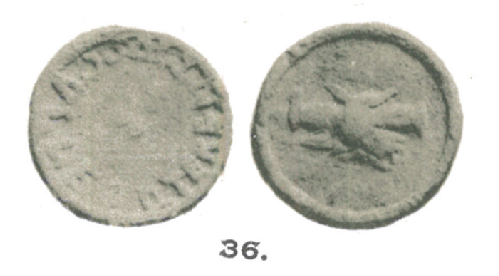 |
Two tokens from the Tiber assemblage: one carries images of a priestly staff (lituus) and an altar, the other the name of Q. Terentius Culleo and clasped hands.
The connection with tessera frumentaria was perhaps created because some of these objects carry the image of a modius with corn-ears; the idea then that these objects were used in corn distirbutions in Rome was an easy conclusion. But when one examines the assemblage from the banks of the Tiber more closely, this interpretation comes into serious question. Dressel published this assemblage, consisting of 487 lead tokens, at the beginning of the 20th century, and concluded that it may have been a hoard dated to around the middle of the first century AD. Examining the imagery of these tokens I was struck by the fact that many of the images chosen, including the modius, imitate or reference the design of Augustan and Julio-Claudian quadrantes, the smallest coin denomination at this time. Twenty-seven tokens carried a modius accompanied by the legend QAE and OPT (?) on either side (Rost. 383); these are 17mm in diameter, roughly the same size as a Roman quadrans.
 |
|
Quadrans of Augustus with clasped hands and moneyer's name.
© Trustees of the British Museum (R.6223)
|
From the same assemblage is a token (18mm) in the name of Q. Terentius Culleo showing clasped hands, a type also found on quadrantes under Augustus. Even the way Culleo's name is presented, around the outer edge of the token in a circle, imitates money of this period. Other tokens carry altars, a lituus, an eagle with open wings, and balanced scales. If you examine the iconography of quadrans from this period (available to view here), you'll find these same images. Given that these tokens came to light in the eighteenth century, its difficult to know for certain if this is a 'hoard'. But Dressel's conclusion, that this assemblage is likely to be the privately produced small change, is a good one given the similarities in imagery and size between these objects and officially produced quadrantes. Dressel believed the 'hoard' was the till of a merchant or innkeeper - the tokens found in highest quantity (carrying an altar on one side and lituus or priestly staff on the other, shown above, and which had 205 examples) were those of the owner; the other tokens were the differing currencies issued by other individuals in the region. It appears then, that in a localised area in Rome, small change may have been privately produced, and circulated alongside official currencies. Some of these tokens carried the imagery and titulature of Nero and Octavia. What does this mean for the imperial image? Its something I am going to work on in the future at an upcoming workshop in Durham.
While some tokens may have served as small change, others obviosuly had other purposes. Stay tuned for more revelations from the ERC-funded Token Communities in the Ancient Mediterranean Project!
Select Bibliography
Dressel, H. (1922). Römische Bleimarken. Zeitschrift für Numismatik 33: 178-183.
Ficoroni, F. (1740). I piombi antichi. Rome, Girolamo Mainardi.
Rostowzew, M. (1903). Tesserarum urbis romae et suburbi. St. Petersburg.
Virlouvet, C. (1995). Tessera Frumentaria. Les procédures de distribution du blé à Rome à la fin de la République et au débout de l'Empire. Rome, École française de Rome.
September 10, 2015
The bitcoin of antiquity? Community Currencies in Roman Egypt
The use of alternative or community currencies and payment systems is often commented upon in the modern day, whether it is the Bristol pound, Bitcoin, or Ithaca hours. Alternative currencies are also springing up in Greece in the face of its monetary crisis, and may form a way of allowing the domestic economy to continue in the face of austerity. Such currencies also probably existed in the Roman world, used when there was a shortage of official governmental currency or small change. Egypt, for example, has furnished thousands of lead tokens, often bearing the names of different cities (e.g. Memphis). These objects have similarities with the official currency of Egypt that was struck in Alexandria (carrying regnal years as dates, for example), and appear to have been used as local currency once the imperial mint ceased large-scale production in c. AD 220.
 |
|
Lead token of Egypt showing a male figure being crowned by Victory
and the Nile riding a hippopotamus, holding reeds and a cornucopia.
Dated to 'Year 3' of an uncertain era. (Dattari 6462, 19.5mm)
|
Particular tokens are found only in very small areas, often within a city and its hinterland, similar to the way that the Bristol pound, for example, is used only in Bristol. It appears then that these objects were used like the community currencies of the present day, facilitating local transactions and economies within a small area. Their use as money is further suggested by the recent publication of a shipwreck found off the Carmel Coast in Israel. The wreck dates from the 3rd century AD, and contained a hoard of 162 coins (including 68 denarii) including a significant quantity of provincial bronze coins (74 in total), and billon coins from Alexandria. Three Egyptian 'tesserae' or tokens were also in the hoard. The interpretation of the hoard is that it is the purse of a sailor, merchant or ship owner who carried a variety of currencies to save on exchange fees in different ports. The tokens, similar to that shown above (but with different designs) are interpreted as tokens for habour services. But, given that the find contexts of similar objects throughout Egypt show them alongside or in similar contexts to official currency, they should be seen as local currency, hoarded by the owner of the purse along with his other local coinage.
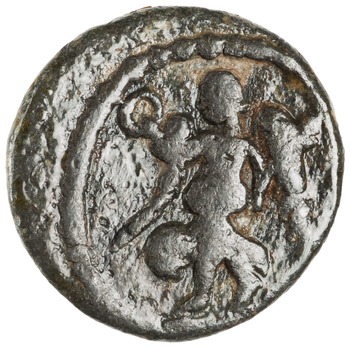 |
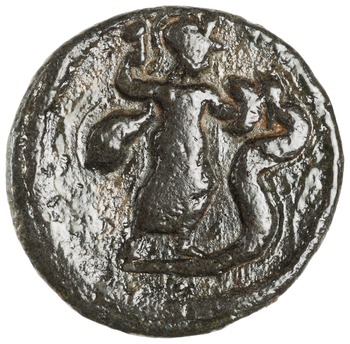 |
These objects shed light on the economic history of Egypt, as well as the self-representation of different groups within the province, similar to the way that the designs of provincial coinage reflect the identities and culture of local cities. That alternative or community currencies existed alongside the denarius system in the Roman Empire reveals how a universal currency used throughout Europe was historically supplemented by other payment systems.
Select Bibliography:
Meshorer, Y. (2010). Coin Hoard from a Third-Century CE Shipwreck off the Carmel Coast, Atiqot 63: 111-135.
Milne, J. G. (1908). The leaden token-coinage of Egypt under the Romans. Numismatic Chronicle 8: 287-310.
Images from Classical Numismatic Group Inc., Electronic Auction 353, lot 369 (www.cngcoins.com), and the American Numismatic Society, 1944.100.79822.
August 01, 2015
Ain't talkin' 'bout love. Roman "Spintriae" in context.
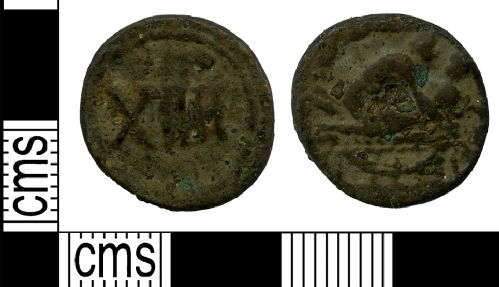 |
| Roman token, found in the Thames, PAS LON-E98F21 |
In 2012 this token was found in the Thames in London, resulting in numerous news articles about this 'brothel token'. The obverse carries the Roman numeral XIIII (14), while the reverse carries a sex scene. The couple are laying on a decorated bed or a couch, the woman laying on her front while a male straddles her.
This token is part of a broader series that carry a Roman numeral between 1 and 16 on one side, and various sex acts on the other. Another series carry Roman numerals on one side and portraits of Augustus, Tiberius or Livia on the other (see below). Buttrey analysed the dies of both series and concluded they were connected; he suggested that these objects date to the Julio-Claudian period and were perhaps gaming tokens, envisaging a possible scenario where one side played 'the imperial portraits' and the other 'the sex scenes', making the game a form of salacious gossip on the sex lives of the Roman emperors.
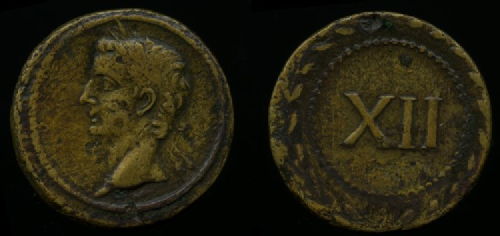 |
| Roman token showing Tiberius and XII within wreath. |
In reality, we know very little about these objects; their sexual scenery has created numerous forgeries, and very few archaeological contexts are known. They are often called spintriae, a label created in the modern era from a reading of Suetonius' Life of Tiberius. As part of the portrayal of Tiberius' activities on Capri, Suetonius records the presence of numerous female and male prostitutes, called spintrias (Suet. Tib. XLIII, see also Tacitus, Ann. VI.1; sphinthria or spintria referred to a male prostitute in Latin, from the Greek σφιγκτήρ, and connected to the Latin/modern word sphincter). It is this tale that inspired early collectors and scholars to label these objects spintriae, and when a hoard of tokens was found on Capri it cemented the name, though they were not called this in antiquity.
Indeed, the known find contexts of these objects suggest they had little to do with sex. Although hundreds of these specimens exist (precise numbers are difficult given the quantity of fakes in existence), only a handful of closed archaeological contexts are known. We cannot know whether the Thames example was lost in antiquity, or more recently. But one example was recently found in a tomb in Mutina; associated ceramics and other coins dates the tomb to AD 22-57, suggesting Buttrey's dating of the Julio-Claudian period is correct. Another was found during an archaeological campaign on the island of Majsan; this was pierced, suggesting it had been transformed into a piece of jewellery. Scattered other examples are reported to have been found in Caesarea Maritima, in the Garigliano in Italy, on Skegness beach (likely a modern loss) and in Germany (Stockstadt am Main, Saalburg, Nendorp-Wischenborg; these are sporadic finds). Although the information on the find places of these objects leaves much to be desired, none of these find spots are brothels, and in each example there is only one 'spintria' found. What their purpose was remains a mystery. Like many Roman tokens, much more study is required before we can fully understand these objects.

This month's coin was chosen by Clare Rowan. Clare is a research fellow at Warwick, who has recently become interested in the role tokens had in Roman society.
Coin images above reproduced courtesy of the Portable Antiquities Scheme and © The Trustees of the British Museum
Select Bibliography:
Benassi, F., N. Giordani and C. Poggi (2003). Una tessera numerale con scena erotica da un contesto funerario di Mutina. Numismatica e Antichità classiche 32: 249-273.
Buttrey, T. (1973). The spintriae as a historical source. Numismatic Chronicle 13: 52-63.
Martini, R. (1997). Tessere numerali bronzee romane nelle civiche raccolte numismatiche del comune di Milano Parte I. Annotazione Numismatische Supplemento IX: 1-28.
Mirnik, I. (1985). Nalazi novca s Majsana. VAMZ 18: 87-96.
 Clare Rowan
Clare Rowan

 Please wait - comments are loading
Please wait - comments are loading

 Loading…
Loading…

